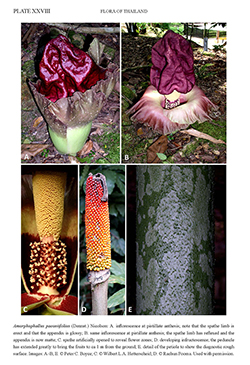e-Flora of Thailand
Volume 11 > Part 2 > Year 2012 > Page 167 > Araceae > Amorphophallus
36. Amorphophallus paeoniifolius (Dennst.) Nicolson
Taxon 26(2–3): 338. 1977; Li & Hetterschied in H.Li. et al., Fl. China 23: 30–31. 2010.— Dracontium paeoniifolium Dennst., Schlüssel Hortus Malab.: 38. 1818. (‘paeoniaefolium’). Plate XXVIII.
Accepted Name : This is currently accepted.
Synonyms & Citations :
Description : Tuber depressed globose, 5–50 by 3–30 cm, root-scars prominent, annulate, offsets produced every season, these thick rhizomatous, to ca 10 by 4 cm. Leaf solitary or two per tuber; petiole 30–200 by 1–20 cm, background colour pale to dark green or blackish green, usually with large and small pale blotches and numerous tiny dark dots, the large blotches often confluent, especially near the base, surface shallowly corrugate to strongly echinate-verrucate, rarely entirely smooth; leaf blade highly dissected, 30–300 cm, rachises narrowly or broadly winged almost to the base; leaflets rounded, ovate, obovate, elliptic, elliptic-oblong, elliptic lanceolate or lanceolate, 3–35 by 2–12 cm, acuminate, adaxially mid green, abaxially mid green or pale green. Inflorescence short pedunculate; peduncle 3–20 by 1–8 cm, often entirely subterranean, usually paler and smoother than petiole; spathe campanulate, broader than long, 10– 45 by 15–60 cm, base and limb often separated by a shallow constriction, limb spreading, strongly undulate, base exterior very variable, background colour ranging from pale green to dark brown, usually with large and small, circular paler spots, base interior lower part deep maroon, upper zone dirty whitish or very pale pinkish, limb exterior as base but with more prominent maroon flushes, especially near the margin, limb interior usually glossy dark maroon, sometimes with a greenish margin, base within densely verrucate, verrucae variable, mostly conical, fleshy; spadix sessile, shorter or longer than spathe, 7–70 cm long; pistillate flower zone cylindrical, 3–25 by 1–12 cm, flowers congested or slightly distant; ovaries depressed, circular in cross-section, 3–5 by 1.5–2.5 mm high, pale green or maroon with a whitish base; style slender, 3–15 by 1–1.5 mm, maroon; stigma large, oval or triangular in cross-section, 4–7 by 3–5 mm, often strongly laterally compressed, then cordate in longitudinal section, shallowly or deeply 2– or 3-lobed, lobes rounded or conical, sometimes with a strong groove on the outward facing side, surface verruculate, pale or deep yellow; staminate flower zone cylindrical or strongly obconical, 2.5–15 by 1–10 cm at the base, 1–20 cm at the apex, flowers congested; staminate flowers 4–6-androus; stamens 4–6 mm, off-white; appendix very variable, inflated, 1.5–30 by 1.2–30 cm, globose, depressed globose, oval or triangular conical (pyramidal), smooth or with various folds and/or irregular shallow depressions, base often with flattened, staminodial structures, apex obtuse or acutish, surface minutely granulate, glossy dark maroon, rarely pinkish or yellow. Infructescence cylindrical, 10–50 by 3–8 cm, long pedunculate; peduncle elongating strongly during fruit development, 20–100 cm, colour changing to uniformly tan, surface with numerous, narrow, transversal cracks; fruit elongate-ellipsoid, 1.5–2 cm by 8–10 mm ripening bright red.
Thailand : NORTHERN: Chiang Mai, Sukhothai; EASTERN: Nakhon Ratchasima; SOUTH-WESTERN: Kanchanaburi; CENTRAL: Krung Thep Maha Nakhon (Bangkok), Saraburi; PENINSULAR: Chumphon, Nakhon Si Thammarat.
Distribution : Madagascar, eastwards via India (type of Amorphophallus rex), S China (type of A. microappendiculatus), to Malesia (type of A. malaccensis), Thailand (types of A. virosus and A. dixenii), Indochina, as far east as Polynesia and N Australia. For detailed typification data see Nicolson, Taxon 26(2–3): 338. 1977.
Ecology : In almost all imaginable secondary conditions, either secondary forests or highly disturbed areas, in dappled shade or fully exposed ground; 0–700 m alt.
Vernacular : Buk (บุก)(throughout the Kingdom); buk khung khok (บุกคุงคก)(Chon Buri); buea (เบือ)(Mae Hong Son); man suran (มันซูรัน)(Central); hua buk (หัวบุก)(Pattani); buk khang khok (บุกคางคก)(Central, Northern); buk nam (บุกหนาม), buk luang (บุกหลวง)(Mae Hong Son); tsjo-dao (โซดาว)(Karen).
CommonName : Elephant yam
Uses: Extensively used as a starch crop in India, elsewhere widely used as a secondary crop in times of rice shortage. Otherwise widely used as fodder.
Notes: Amorphophallus paeoniifolius has been in cultivation throughout tropical Asia for centuries and has been transported by human tribes in many directions. It is therefore unknown which part of its present-day distribution is natural. It may even turn out that it is domesticated, rather than a natural species.

